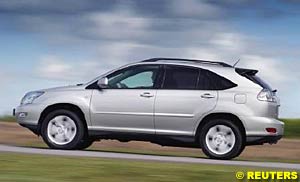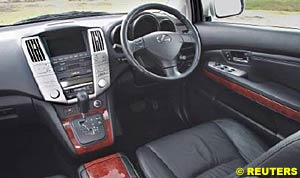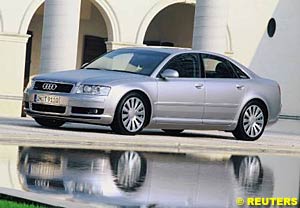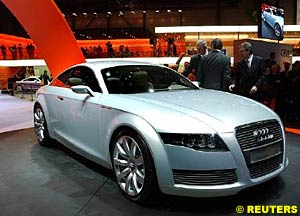

Automotive News and Reviews for the Petrolhead
Reuters Motoring Commentator
In this week's issue:
- Lexus' Likeable RX300
- Audi A8 Quattro Becomes Real Competitor
Lexus is an unusual brand.
In 1983 Eiji Toyoda chaired a top-secret meeting at Toyota's head offices in Japan and outlined a blueprint for producing a large luxury saloon to rival Mercedes-Benz or Jaguar. Seven years later, the LS400 went on sale and immediately set new benchmarks for quality, refinement and performance. In the two decades since, Lexus has become a motoring metaphor for such qualities, annually accumulating prestigious JD Power awards for customer satisfaction, on both sides of the Atlantic.
Last year it sold over 240,000 cars in the U.S., a country with a population of 287 million people, outperforming BMW and Mercedes-Benz. In Europe, with a population of 728 million, it sold just 21,000 vehicles all year. BMW and Mercedes each sell more cars than that inside three months in the UK alone.
The RX300, Lexus' 4x4 sports utility vehicle (SUV), is a perfect case in point. Since launch in 1998, it has chalked up sales of over half-a-million units. Over 350,000 of these sit on American driveways; less than 5,000 have been bought by Britons. It's almost as if we don't really know it exists. But now, an all-new RX300 has been launched and Lexus has big ambitions for the car, projecting UK sales of almost 4,000 units next year.
An Identity is Born
So is it any good? The short answer is yes, very, which is great news for Lexus, but the even better news is it also has that extra something missing from much of the rest of the range: a sense of its own identity. There are three versions (the RX300, RX300 SE and RX300 SE-L) and each competes with the likes of the BMW X5 and M Class Mercedes in the highly competitive 4x4 'soft-roader' market but in many ways, this Lexus SUV defies straightforward categorisation. There is something a little more individual and rather less prescriptive about it and Lexus executives feel sure they will draw customers from all sectors, including saloon car drivers, coupe drivers etc.
What is for certain is that the RX300 does look a bit weird. But it's weird in a good way. At first sight, it is definitely a bit of a challenge and won't be to everyone's taste but the lunar-landing styling grows on you. The car perhaps looks better in a dark colour and the LED rear lights and clear Xenon units up-front lend it a sharp, futuristic look. Importantly, the styling makes this Lexus the most aerodynamic vehicle in its class, but ultimately it is the idiosyncrasies that help define its identity and character.
Which become ever more appealing once you climb inside. The interior is wonderfully cosseting and there is so much room! Only the very tallest of drivers will struggle to (electrically) adjust both seat and steering wheel into a perfect position. For front and rear seat passengers there are impressive amounts of leg-room, while the rear seats can be split in a number of combinations and slide forward independently to create additional load space where desired.
Excellent Fittings
The specification of all three models is dazzling. Like its rivals from Mercedes and BMW, the RX300 is splendidly engineered and properly screwed together but what it lacks in badge bravado is more than compensated for by its levels of standard equipment. The functionality and ergonomics of these fixtures and fittings are generally excellent and the car has some neat features. Cruise control, air-conditioning and an in-dash CD auto-changer are all standard on the £28,955 base model, while the optional Navigator pack, including satellite navigation, parking assist monitor and rear-view camera to help make reversing easier than ever, is standard on the top-of-the-range SE-L model.
For £37,705 you also get reclining rear seats, a power-operated rear door (the finest car-gadget ever invented), heated front seats and intelligent, swivelling headlights. The lights are part of an impressive set of passive and active safety features, which includes more airbags than a WI convention (nine in total, including a world first 'knee-bag', under the dash) and a full suite of electronic traction, stability and braking aids.
Stunning Sounds
And then there's the 11-speaker Mark Levinson audio system, original equipment on the SE-L. Lexus has an exclusive agreement with this leading U.S. home audio specialist and it's not difficult to see why. Hearing is most definitely believing but the system incorporates some very clever thinking. Phil Muzio, CEO of Mark Levinson, says his designers ignored typical in-car obstacles and concentrated on what they could actually control, seeking to virtually eliminate traditional causes of interference, such as insubstantial speaker housings, for example. The quiet refinement of the Lexus cabin creates a natural auditorium and the clarity and detail of the sound is simply stunning.
Which is a shame, because despite the missing 10% of power this Lexus can be hustled along quickly and is a decent handling vehicle. It sits on a monococque chassis and the suspension is another of its technical virtues. The two lower specification models feature a MacPherson strut and coil spring set-up while the SE-L rides on an advanced air suspension system. Having driven both versions, aside from the extra features the air system offers (adjustable ride height, auto-levelling function) it was difficult to tell them apart. On road, the ride in both is fabulously smooth while on a modest off-road test, the Lexus performed adequately but it is no mountain goat. The absence of any limited slip differential or low-range transfer gearbox could make slippery hill descent a bit of a lottery.
But for most luxury off-roaders, multi-storey car parks and sweeping gravel drives are more familiar terrain and the Lexus deserves its place among this crowd. Its looks may be 'interesting', which is better than them being bland, and in top-of-the-range specification it certainly isn't cheap, but the entry-level model is a sub-£30,000 luxury SUV, and there aren't many of those on the market. Overall, the RX still costs less, performs the same and is more economical than its Benz or BMW rival and it also offers class-leading emissions figures, strong residuals and that ultra-impressive level of specification.
Undoubtedly many people will still find the image of the three-pointed-star too tempting to resist and the driving characteristics of the X5 make that the most sporting 4x4 by far, but the smarter money will be spent on the RX300. This is one Lexus with an identity all of its own.
Audi has always been something of an also-ran in the directors' car park stakes.
The presidential S-class remains out of reach for Audi, but now the company thinks it has discovered how to get to get closer to the sales achieved by Jaguar and BMW. Pack the new A8 with more technology than the American war machine, give it more grip and grunt than its two wheel drive rivals and clothe it in a discreet body. By 2004, the company believes, this formula will have helped them ramp up A8 sales to around 1500. Will they achieve it? Maybe...
Technology Has the Answer
Audi has scored a bullseye with its technology. Standard equipment includes class-standard items such as acoustic parking sensors at front and rear, servo-assisted boot lid locking, speed sensitive power steering and a plethora of airbags.
It also has a multi-media interface control system to control everything from radio tuning and instrument lighting to satellite navigation and even a timer for the air conditioning. Even better, the MMI control is easy to use - unlike the ostensibly similar iDrivesystem in the big BMW.
The A8 is even more impressive in its 'personalisation power'. The door mirrors, seat belt height adjustment and 14-way adjustable front seats are not only electric-powered, but also offer memory functions. The adaptive air suspension system allows the driver to adjust the ground clearance from the standard 120mm to 100mm for 'sport', 95mm for 'motorway' or 145mm for any bumpy off-road excursions.
There are other toys to show off too. The gear change 'paddles' beside the steering wheel allow you to change up or down through the six-speed automatic gearbox without having to take your hands off the wheel. In reality, drivers are likely to simply set the transmission to 'D' for drive or push the lever backwards and forwards for up and down, but the 'Formula One factor' will win you kudos.
The one standard gadget that really does warrant praise is the parking brake. Instead of a handbrake lever, there is a central button instead to put the parking brake on. But rather than pressing it again to release the brake, one simply has to press the accelerator. It might sound odd, but it works well.
If that is not enough in the gadget game, then the options list is a happy hunting ground. It reads like a science fiction novel, with everything from adaptive cruise control that maintains the required distance from the car in front to a memory system that reads ones fingerprint and adjusts not only the seats and mirrors, but also the heating and the stereo settings.
Move Along
The new A8 scores almost as highly out on the road. In terms of power, it beats all its class rivals with a mighty 335bhp. It ranks top for power-to-weight ratio too, despite the additional 250kg extra weight of the standard four wheel drive system. Audi has achieved this feat by using a lightweight aluminium body that is 50% lighter than an equivalent steel body.
The idea of using aluminium this way is not new. The Audi A8 has had an aluminium body since 1994 and the new generation Jaguar XJ has just followed suit.
But even in comfort mode, ride quality cannot quite match the A8's rivals and the ZF gearbox loses its polish when the driving gets aggressive. The 3.7 and 4.2-litre V8 petrol engines are thirsty, too, and even the forthcoming 4.0-litre V8 turbo-diesel hardly makes the grade as an eco-warrior. For those who couldn't give a damn, there will even be a 6.0-litre version with 12 cylinders from the end of the year, but it's likely to win fewer fans than the 6-cylinder models due in late 2004.
Where the A8 falls behind its rivals is in terms of ride comfort. While the spacious interior design is arguably the best in its class and the driving position is delightful, the overall package is spoilt by the sensitivity to the road surface. Against the sumptuous ride comfort of the Mercedes, it often feels unrefined and can get noisy on less than perfect roads.
The Big Win?
Depreciation costs for the A8 will meet or beat class rivals, but the strongest card on the cost front is a 5-year/75,000 mile service and maintenance package costing just £500. It's just as well, because the A8 carries a higher insurance cost than its rivals and a contract hire package will be approximately 10% higher than a Jaguar XJ8.
The A8's only real weak spot is its styling. It is less radical than the controversial 7-series and far more contemporary than the Jaguar, but it looks anonymous and plain next to either of them - and distinctly mass-market next to the class-leading Mercedes S-class.
Audi claims this is a strength. Many affluent motorists prefer understated styling, they claim, and will gravitate towards the A8. They could be right, of course, but the new models revealed since the appointment of their new design chief suggest that Audis will be much bolder and more distinctive in future.
Will it be a winner for Audi? Probably. The Mercedes S-class retains its class leadership, but for those seeking an alternative, the choice is no longer so clear-cut. The conservatism of the new Jaguar XJ8 and the controversial looks of the BMW 7-series are alienating potential buyers in equal number and the Audi A8 looks set to become a realistic alternative to the Mercedes for the first time ever.
Written by David Sumner Smith.
![]() Lexus' Likeable RX300
Lexus' Likeable RX300
 So here we have a luxury car brand with an excellent range of products, strong sales and some of the most satisfied customers in the world, all achieved from a standing start in less than 20 years. But there is something missing Lexus doesn't really have an identity. In America, Lexus' most important market by far, the indigenous tendency to prioritise quality and value over everything, coupled with its people's caricatured lack of imagination, means that Lexus is America's number one luxury car brand.
So here we have a luxury car brand with an excellent range of products, strong sales and some of the most satisfied customers in the world, all achieved from a standing start in less than 20 years. But there is something missing Lexus doesn't really have an identity. In America, Lexus' most important market by far, the indigenous tendency to prioritise quality and value over everything, coupled with its people's caricatured lack of imagination, means that Lexus is America's number one luxury car brand.
 The RX300 is a good drive too. The 201bhp 3.0 litre V6 engine makes all the right noises, is reasonably refined and performs well from low speed, aided by the largely impressive five-speed automatic gearbox. But there is just a little something missing. When you're looking for that extra burst of acceleration, the search proves fruitless and at peak revs, the engine can get quite raucous but nothing really happens as this (virtually) two tonne 4x4 leaves you wanting more. In full auto setting, the gearbox is smooth and impressive while a flick of the lever to the left offers the driver a sequential manual alternative. The system works well, aside from the software's tendency to delay up-shifts dashing all out-and-out sporting aspirations.
The RX300 is a good drive too. The 201bhp 3.0 litre V6 engine makes all the right noises, is reasonably refined and performs well from low speed, aided by the largely impressive five-speed automatic gearbox. But there is just a little something missing. When you're looking for that extra burst of acceleration, the search proves fruitless and at peak revs, the engine can get quite raucous but nothing really happens as this (virtually) two tonne 4x4 leaves you wanting more. In full auto setting, the gearbox is smooth and impressive while a flick of the lever to the left offers the driver a sequential manual alternative. The system works well, aside from the software's tendency to delay up-shifts dashing all out-and-out sporting aspirations.
![]() Audi A8 Quattro Becomes Real Competitor
Audi A8 Quattro Becomes Real Competitor
 Alongside exalted competitors like the Mercedes S-class and BMW 7-series, it has lacked the distinctive looks and the prestige badge. Sales of the big A8 saloon have been dismal. While Audi sales in the UK have grown by more than 50% in the last two years to a record high, the A8 accounted for just one in every hundred Audi sales. It might have outsold the big Lexus LS saloon, but around three examples of the aged Jaguar X-type and the controversial new BMW 7-series were sold for every one of the unloved Audi. The Audi's total of 686 sales looks pitiful against the 2883 achieved by the Mercedes S-class.
Alongside exalted competitors like the Mercedes S-class and BMW 7-series, it has lacked the distinctive looks and the prestige badge. Sales of the big A8 saloon have been dismal. While Audi sales in the UK have grown by more than 50% in the last two years to a record high, the A8 accounted for just one in every hundred Audi sales. It might have outsold the big Lexus LS saloon, but around three examples of the aged Jaguar X-type and the controversial new BMW 7-series were sold for every one of the unloved Audi. The Audi's total of 686 sales looks pitiful against the 2883 achieved by the Mercedes S-class.
 Where the A8 picks up most points is in terms of its adaptability. With the transmission set to 'drive', the double-glazed windows shut and the suspension on 'comfort', the A8 feels safe, sophisticated and serene. Switch to the sport ratios and the lowered suspension and it is quickly transformed into a muscle car with excellent grip from the 4WD transmission. Even the exhaust system has been tuned to let the enthusiast savour the beefy sound of the 4.2-litre V8.
Where the A8 picks up most points is in terms of its adaptability. With the transmission set to 'drive', the double-glazed windows shut and the suspension on 'comfort', the A8 feels safe, sophisticated and serene. Switch to the sport ratios and the lowered suspension and it is quickly transformed into a muscle car with excellent grip from the 4WD transmission. Even the exhaust system has been tuned to let the enthusiast savour the beefy sound of the 4.2-litre V8.
© 1995-2005 Kaizar.Com, Inc. . This service is provided under the Atlas F1 terms and conditions.
|
Volume 9, Issue 22
Atlas F1 Exclusive
Jos the Way It Is
Giancarlo Fisichella: Through the Visor
Articles
Remembrance of Things Past
Murphy & the Franco-American Special
Season in the Sun III
The Fuel Stop: Special Edition
Monaco GP Preview
The Monaco GP Preview
Monaco GP Facts & Stats
Columns
The F1 Trivia Quiz
Bookworm Critique
On the Road
Elsewhere in Racing
The Weekly Grapevine
> Homepage |